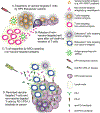The promise of combining cancer vaccine and checkpoint blockade for treating HPV-related cancer
- PMID: 31302573
- PMCID: PMC6710123
- DOI: 10.1016/j.ctrv.2019.07.001
The promise of combining cancer vaccine and checkpoint blockade for treating HPV-related cancer
Abstract
Human papillomavirus (HPV)-associated intraepithelial neoplasia or cancers are ideal candidates for cancer immunotherapy since HPV oncoproteins, such as E6 and E7 proteins of high-risk HPVs, could be utilized as foreign antigens. In HPV-associated cancers as well as nonviral cancers, the cancer cells may evade host immunity through the expression of immune checkpoint molecules, downregulation of human leukocyte antigen, and activation of immune regulatory cells. Because of these immune suppressive mechanisms, HPV therapeutic vaccines have shown little efficacy against HPV-associated cancers, although they have shown efficacy in treating HPV-associated intraepithelial neoplasias. Recently, checkpoint blockade emerged as a promising new treatment for solid cancers; however, these therapies have shown only modest efficacy against HPV-associated cancers. Here we reviewed literature analyzing a combinatory therapy using an immune checkpoint inhibitor and an HPV therapeutic vaccine for treating HPV-associated cancers to compensate for shortfalls of each monotherapy. Complimentary modes of T cell activation would be deployed; as vaccines would directly stimulate the T cells, while checkpoint inhibitors would do so by releasing inhibition. Some promising studies using animal models and early human clinical trials raised a possibility that such combinations may be efficacious in regressing HPV-associated cancers. Epitope spreading (the phenomenon in which non-targeted antigens become new targets of immune response) may play a critical role mechanistically. Currently ongoing studies will shed light as to whether such combination therapy would indeed be a promising new treatment paradigm. Current and future studies must also determine the adverse effect profile of such a combination treatment.
Keywords: Cervical cancer; Checkpoint blockade; Human papillomavirus; Immunotherapy; Therapeutic vaccine.
Copyright © 2019 Elsevier Ltd. All rights reserved.
Figures

Similar articles
-
Mucosal HPV E6/E7 Peptide Vaccination in Combination with Immune Checkpoint Modulation Induces Regression of HPV+ Oral Cancers.Cancer Res. 2018 Sep 15;78(18):5327-5339. doi: 10.1158/0008-5472.CAN-18-0892. Epub 2018 Jul 27. Cancer Res. 2018. PMID: 30054333 Free PMC article.
-
HPV vaccination and the effects on rates of HPV-related cancers.Curr Probl Cancer. 2018 Sep;42(5):493-506. doi: 10.1016/j.currproblcancer.2018.06.004. Epub 2018 Jun 23. Curr Probl Cancer. 2018. PMID: 30041818 Review.
-
Therapeutic DNA Vaccines for Human Papillomavirus and Associated Diseases.Hum Gene Ther. 2018 Sep;29(9):971-996. doi: 10.1089/hum.2017.197. Epub 2018 Mar 16. Hum Gene Ther. 2018. PMID: 29316817 Free PMC article.
-
Therapeutic Vaccines Against Human Papilloma Viruses: Achievements and Prospects.Biochemistry (Mosc). 2019 Jul;84(7):800-816. doi: 10.1134/S0006297919070101. Biochemistry (Mosc). 2019. PMID: 31509730 Review.
-
Therapeutic vaccines for high-risk HPV-associated diseases.Papillomavirus Res. 2018 Jun;5:46-58. doi: 10.1016/j.pvr.2017.12.006. Epub 2017 Dec 19. Papillomavirus Res. 2018. PMID: 29277575 Free PMC article. Review.
Cited by
-
SNP-Target Genes Interaction Perturbing the Cancer Risk in the Post-GWAS.Cancers (Basel). 2022 Nov 17;14(22):5636. doi: 10.3390/cancers14225636. Cancers (Basel). 2022. PMID: 36428729 Free PMC article. Review.
-
Nanoparticle-based applications for cervical cancer treatment in drug delivery, gene editing, and therapeutic cancer vaccines.Wiley Interdiscip Rev Nanomed Nanobiotechnol. 2021 Sep;13(5):e1718. doi: 10.1002/wnan.1718. Epub 2021 May 4. Wiley Interdiscip Rev Nanomed Nanobiotechnol. 2021. PMID: 33942532 Free PMC article. Review.
-
Heterologous prime-boost immunization co-targeting dual antigens inhibit tumor growth and relapse.Oncoimmunology. 2020 Nov 9;9(1):1841392. doi: 10.1080/2162402X.2020.1841392. Oncoimmunology. 2020. PMID: 33224629 Free PMC article.
-
Advances and Challenges in the Treatment of HPV-Associated Lower Genital Tract Cancers by Immune Checkpoint Blockers: Insights from Basic and Clinical Science.Cancers (Basel). 2025 Apr 8;17(8):1260. doi: 10.3390/cancers17081260. Cancers (Basel). 2025. PMID: 40282436 Free PMC article. Review.
-
Reprogramming tumor-associated macrophages and blocking PD-L1 via engineered outer membrane vesicles to enhance T cell infiltration and cytotoxic functions.J Nanobiotechnology. 2025 Jul 15;23(1):514. doi: 10.1186/s12951-025-03507-7. J Nanobiotechnology. 2025. PMID: 40660251 Free PMC article.
References
Publication types
MeSH terms
Substances
Grants and funding
LinkOut - more resources
Full Text Sources
Other Literature Sources

